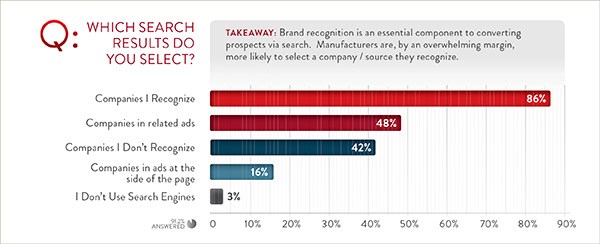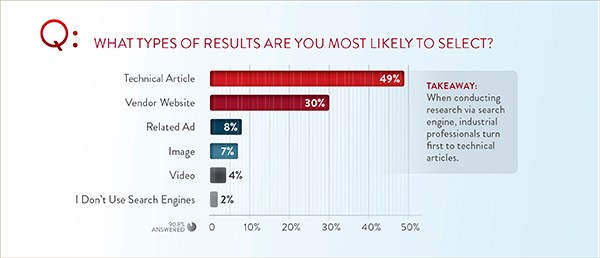Gardner’s Media Usage in Manufacturing 2014 – Part 4: Customers Seek Answers
Insights: Buying Cycle and Vendor Selection
It’s said knowledge is power . . . never truer than in the “Information Age.” This is part 4 of a 6 part series of articles, discussing the findings of Gardner Business Media’s research study, Media Usage in Manufacturing 2014 and what they might mean to the B2B marketer.
When Customers Search, You Need to Be One of the Usual Suspects
Insights: “Push” Media Is Still Effective, but Digital “Pull” Grows in Importance . . . and Brand Tips the Scales There, Too!
By Mark Semmelmayer
Chief Idea Officer
Pen & Inc. Marketing Communications

This is part 4 of a 6 part series, discussing Gardner Business Media’s research study, Media Usage in Manufacturing 2014. The series breaks down study findings, and their implications for the B2B marketer. Download the report here.
In this post, we’ll explore a noticeable shift in buying process. The survey reveals traditional “Push” media still has the greatest impact on manufacturing buyer behavior. But, the survey also shows digital marketing becoming increasingly important in at least one area: the use of search engines.
You Could Google It . . .
Funny. A single word can wind up representing an entire category of things or activities. Like my former employer, Kimberly-Clark’s Kleenex® brand, which is synonymous with facial tissue. That’s what Google has become. A synonym for search engines and internet search. Netscape and Yahoo are older and still there . . . and Bing has Microsoft behind it . . . but we all “Google” things.
So does the manufacturing buyer, in increasing numbers, placing increasing importance on relevant search results in the vendor selection process. As a “Pull” medium, a marketer’s successful returns in a buyer’s search are critical. They provide prospects with information they need but weren’t sure where to find it.

Search Returns Ramp up Awareness . . .
Ever heard the expression “half of life is just showing up”? At a minimum, the same can be said for the value of your search engine strategy. Like “Push” media, search marketing success is still reliant on “reach” and “frequency,” but those terms need to be defined differently than those terms applied to print media.
Reach
An informative post by Paul Bruemmer, “The Importance of Search Engine Optimization/Search Engine Marketing for B2B Marketers”, featured on Marketing Today, pretty much defines search engine reach. Citing a study, “The Role of Search in Business to Business Buying Decisions,” he states:
• 93.2 % of participants indicated they would research the purchase online
• Search engines play a dominant role in B2B purchases
• 95.5 % indicated that they would use a search engine
• Google is favored over other search engines
• Search engine research takes place at least 1 to 2 months before buying
Frequency
The Gardner Study results show manufacturing buyers use search both early and often in the buying cycle.
• 71% of respondents look for products and services at least once a week
• 26% do it daily
That’s what I mean about showing up being half the game. The other half?
. . . When Searchers Find What They Want
Gardner’s survey results are pretty specific with regard to what the buyer values in search returns.

Compound these facts with other Survey findings that indicate what searchers find credible in search results,
• Technical articles are the most likely selected search return
• Technical / editorial content is most influential factor in vendor perception
. . . and you get a pretty clear picture of what they are looking for.

Practical Implications: Your Search Marketing Strategy Needs To Be an Integrated Effort
1. Your search strategy and its maintenance is the fundamental job of your digital team. But, that function needs integration with your broader, integrated marketing communications strategy, including your “Push” media.
2. With “Push” media, you’re in charge of content and information. With “Pull” media, the buyer’s in charge. Fundamentally, it means that wherever your buyer goes to get information, you need to show up. Insight into buyer search “consumption” and application of that insight across your communications planning is important.
3. Ads on search pages (paid search), creates marginal impact at best. This tells us organic search results, the end-point of search engine optimization (SEO) can’t be understated. You need to ask yourself if a pay-per-click (PPC) strategy’s return is worth the investment.
4. A second critical role for your digital team is content marketing. Manufacturing buyers trust expert technical content when forming purchasing decisions. Invest in content creation and focus on content placement where manufacturers look for solutions.
5. Last but not least: Regardless of shifting media use and preference among buyers, some things in marketing have not and will not ever change. Brand has a primary influence on where and at whom buyers look to for solutions. Creating and/or maintaining your brand, in the B2B space, is becoming a multi-faceted discipline . . . but it’s still Job #1.
Need more information?
Mark Semmelmayer
Chief Idea Officer
Pen & Inc. Marketing Communications
Marietta, GA
770-354-4737
LinkedIn


